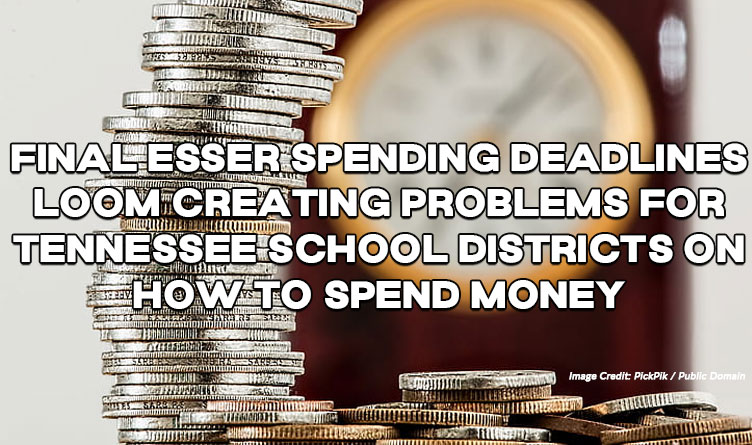Many Who Have Opposed The Spending Spree The Federal Government Embarked On In The Name Of COVID Say That The Reliance On Federal Dollars Is Exactly The Goal And Now The Issues Of Disentangling Tennessee State Systems From Such A Burden Will Be Time Consuming And Very Likely, Hurt Much More Than They Helped.
Image Credit: PickPik / Public Domain
The Tennessee Conservative [By Kelly M. Jackson] –
According to this report, the final deadline for spending the billions of dollars sent to school districts across the country is just around the corner, creating an interesting conundrum for those districts: how do you spend all of that money without creating circumstances that will obligate you to a need for those funds in perpetuity?
The short answer to this appears to be – you can’t. A conclusion that the more cynical American would come to, is that these federal funds are a way of addicting public programs and institutions to money that they ordinarily aren’t entitled to on a regular basis.
The perceived end game being that if these organizations come to rely on federal funds, they will do nearly anything to keep them. Many believe this gives the source of those funds outright control in ways they never were intended.

It would seem counterproductive to accept money that would create opportunities that would then require a steady flow of cash in order to be maintained.
Yet, because of the time constraints placed on those who have accepted the funds, this is exactly what many school districts have done.
According to reports, federally imposed deadlines are causing an accelerated spending timeline. As of March of this year, ESSER funds spending in school districts was at a pace of about 5.1 billion per month.
The higher expenditures seem to be focused more on social emotional learning, rather than using the funds to extend the school year, which one would think would have a more direct positive impact on learning loss from COVID era lockdowns and the deprivation of in-person learning for months and in some cases, years.
The biggest issue, however, is what is being called the “fiscal cliff” that many schools will be plummeting from due to the commencement of federal dollars distributed all over the country to offset what they anticipated as “learning deficits”.

While the federal government would say they meant for the funds to be spent on resources that will address in their estimation, those “academic shortfalls,” the funds are being spent in ways that will not further obligate them to future expenditures that they are uncertain they can meet.
It is this very issue of financial uncertainty that is leading some districts to impose huge cuts in their budgets, scaling back programs with recurring costs, and opting for more static expenditures such as new facilities, or improvements to those already in existence.
The implications of this include not only a loss of services for students, but job losses for those who deliver those services and the fiscal impact on those individual households as a result.
The list of where the money can be spent is voluminous, but communities who want to be able to best utilize these funds before it is too late, are finding themselves in a position where they are forced to shift dollars before those dollars evaporate into thin air.
There is a current dispute, for example, in Hamilton County where $1 million dollars in COVID relief funds initially promised to the Hamilton County chapters of the Urban League and the Sankofa Civic Engagement Organization is being reallocated by the County Commission in Hamilton County for a turf field at Howard school of Academics and Technology.
The argument from community leaders for the change is that the football field will benefit the entire community, but it can’t help but be noticed that it is a one-off expenditure, versus being directed to organizations where the funds may become relied upon for continued use.

The deadline for all funds to be redeemed and used expires at the end of January 2024. Many who have opposed the spending spree the federal government embarked on in the name of COVID, would say that the reliance on federal dollars is exactly the goal and now the issues of disentangling our state systems from such a burden will be time consuming and very likely, hurt much more than they helped.
The fact that the money cannot be banked and must be spent is what is creating this “beat the clock “type of scenario, where moneys intended to mitigate what was expected to be a learning disruption, will be spent on items that have little if nothing to do with those intentions.
The end result in many cases will be that millions of tax dollars have been and will be under-utilized or wasted entirely.
Like many other initiatives the federal government imposed from the onset of the pandemic through present day, a complete understanding of the extent of the damage may not be revealed for decades to come.


About the Author: Kelly Jackson is a recent escapee from corporate America, and a California refugee to Tennessee. Christ follower, Wife and Mom of three amazing teenagers. She has a BA in Comm from Point Loma Nazarene University, and has a background in law enforcement and human resources. Since the summer of 2020, she has spent any and all free time in the trenches with local grassroots orgs, including Mom’s for Liberty Williamson County and Tennessee Stands as a core member. Outspoken advocate for parents rights, medical freedom, and individual liberty. Kelly can be reached at kelly@tennesseeconservativenews.com.


